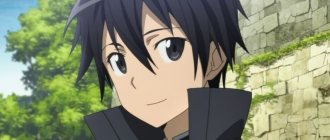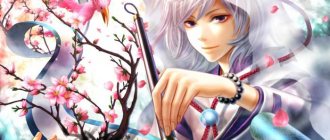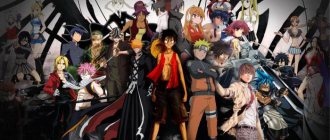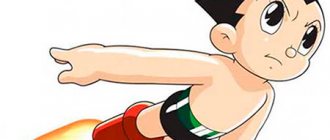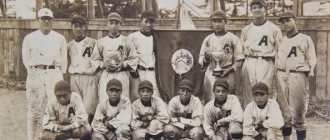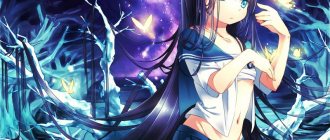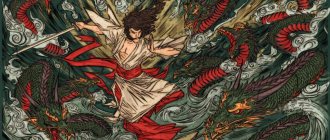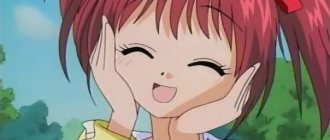Tsundere (Type A)
The Tsundere is probably the most popular archetype on this list. Such characters constantly switch between their states of “tsun” (rudeness) and “dere” (falling in love, tenderness). They often say “baka” for no reason and try to hide their good deeds behind a rude disposition. It is useful to divide tsunderes into two types.
The first type is more consistent with the word "tsun". Such characters tend to verbally and physically insult the object of their affection, and are embarrassed when they are praised.
Typical examples: Taiga Aisaka (Toradora! / Toradora!), Louise Françoise le Blanc de la Vallière (Louise-Zero's Henchman / Zero no Tsukaima), Chitoge Kirisaki (Fake Love / Nisekoi)
A hero archetype is a certain stereotypical model of the character of characters in anime, manga, light novels and visual novels. It has become a feature of these works, and in some cases, a type of fan service.
Attention "
Leave a link to the site somewhere on your site or read this. Otherwise they will come after you.
Archetypal characters are found especially often in romantic, harem and hentai visual novels; in more serious works, authors try not to use archetypes so as not to create templates. Nevertheless, often even among complex characters there are heroes who can still be classified as a certain model. There are plenty of varieties of archetypes, but some types of characters are mistakenly classified among them.
It is important to note that the traits of male characters are always less pronounced than those of female characters. If you do not take into account the hybrid ones, then there are six key archetypes: tsundere, kudere, dandere, yandere, genki and moe. Moreover, the traits of some of them are opposite, forming the following pairs: tsundere-genki, kudere-dandere, moe-yandere. In other words, it turns out that any hero can combine the traits of a maximum of three of these archetypes.
Tsundere. Prickly, boorish, sometimes even aggressive on the outside, but sensitive, romantic, and often vulnerable on the inside. Such heroes are characterized by excessive, sometimes even feigned stiffness, which gives them away. They try to hide their true feelings with all sorts of excuses, often even to themselves. The tsundere is the most famous and popular archetype, as well as a type of fanservice in which a character shows their romanticism in an appropriate way or becomes embarrassed despite their character. The opposite archetype is genki, since, unlike tsunderes, they are characterized, on the contrary, by excessive straightforwardness.
Examples of tsundere girls: Sanzenin Nagi (anime “Hayate, the Combat Butler”) Aisaka Taiga (anime “Toradora”) Louise de la Vallière (anime “Louise-Nulisa’s Henchman”) Shana (anime “Fire-Eyed Shana”)
Examples of tsundere guys: Shido Maria (anime “Maria Holik”) Akasaka Ryunosuke (anime “Kitty from Sakurasou”)
Four Tsundere Wonders »
This is what the heroines presented in the examples are generally called. It is noteworthy that they are similar not only in character, but also in appearance, and were also voiced by the same seiyuu - Kugimiya Rie. By the way, she often voices tsundere characters.
Kudere. Excessively phlegmatic, silent, calm and unperturbed. They practically do not show their emotions. It’s not that they don’t have them at all (although this also happens), it’s just that such characters have remarkable control over themselves. They rarely talk. Kudere characters are often various kinds of androids, aliens and other representatives who are not characterized by human emotions. Even despite the external similarity, the opposite archetype is the dandere, since, unlike the kudere, they have no control of emotions at all.
Related temperament: phlegmatic.
Examples of kuudere girls: Ayanami Rei (anime "Evangelion") Nagato Yuki (anime "The Melancholy of Suzumiya Haruhi") Reki (anime "Aria - the Scarlet Bullet") Misaki Mei (anime "Another")
Examples of kuudere guys: Kuroko Tetsuya (anime “Kuroko’s Basketball”) Koshigaya Suguru (anime “Wilderness”)
Dandere. Silent and withdrawn, overly insecure, even to the point of phobias. They are overly emotional and shy, they always think a lot, worry and overthink themselves, and often have unhealthy self-criticism. Some of them avoid the company of other people, preferring to communicate with a diary, some are embarrassed to even talk. At the same time, people are usually romantic. The opposite archetype is the kuudere, since they, unlike the dandere, are imperturbable.
Related temperament: melancholic.
Examples of dandere girls: Shiomiya Shiori (anime “The World Only God Knows”) Onodera Kosaki (anime “Fake Love”) Hyuga Hinata (anime “Naruto”)
Examples of dandere guys: Oyamada Kota (anime "Kanokon") Amano Yukiteru (anime "Future Diary")
Yandere. Aggressive, cruel, too emotional, capable of crimes, although they combine some traits that can be called cute. Some yanderes acquire these traits only under pressure from circumstances, some are like this on their own. The latter often have a tendency towards sadism. As a rule, yanderes are easy to kill. The opposite archetype is the moe, since they, unlike the yandere, are pure and innocent.
Related temperament: choleric.
Examples of yandere girls: Gasai Yuno (anime "Future Diary") Katsura Kotonoha (anime "School Days") Sonozaki Shion (anime "When Cicadas Cry")
Examples of yandere guys: Accelerator (anime "Magic Index")
Yandere and Yangire »
It is believed that if a character commits atrocities out of love, then he is a yandere, but if for no reason, then he is a yangire. Such a division is at least strange: a predisposition to cruelty is either present or not, and love in this regard is simply the reason. The most common, due to the specifics of this feeling, but by no means the only one and, even more so, not something special. Another thing is that a character’s sadism can always manifest itself, or maybe only under certain circumstances. For example, Ryugu Rena from the anime “When Cicadas Cry” is very peaceful in itself, but she will never let anyone offend her and is very scary in moments of fighting for her life. In other words, all yanderes are yangire, but not all yandere are yandere. Despite this, the name “yandere” was assigned to characters prone to cruelty.
Genki. Very energetic and optimistic, friendly and cheerful. They often seem carefree. Although in most cases they only seem to be: many of them are still able to bear the burden of responsibility for their words and actions. Almost always have good performance in sports. Genki characters are, for the most part, virtually incapable of embarrassment. The opposite archetype is the tsundere, since, unlike genki, they are characterized, on the contrary, by excessive stiffness.
Related temperament: sanguine.
Examples of genki girls: Sujimiya Haruhi (anime “The Melancholy of Suzumiya Haruhi”) Sonozaki Mion (anime “When Cicadas Cry”) Mifune Ryuko (anime “Radio Signal from a Weird Girl”)
Examples of genki guys: Minamikokubaru Daigo (anime “Bridge to the Starry Sky”) Kida Masaomi (anime “Durarara!”)
Moe. Pure, sweet and innocent, often shy, naive, somewhat clumsy. In other words, a moe character is something overly charming. It often happens that a guy of this archetype is attractive to guys as well. Also, the word “moe” can simply be used to describe something cute (this is the actual meaning of the word). Often those around them strive to protect moe characters and help them in everything. The opposite archetype is the yandere, since they, unlike moe, on the contrary, are overly dangerous.
Examples of moe girls: Takara Miyuki (anime “Lucky Star”) Asahina Mikuru (anime “The Melancholy of Suzumiya Haruhi”) Towa Erio (anime “Radio Signal from a Weird Girl”)
Examples of moe guys: Hoshino Ayumu (anime "Bridge to the Starry Sky") Totsuka Saika (anime "The Romantic Comedy of My Youth is Worse Than I Expected")
Moe-dandere »
Often the moe and dandere archetypes are combined into one. There are many reasons. Firstly, the moe traits - sweetness and innocence - and the dandere traits - modesty and shyness - complement each other very well. Secondly, modesty in most cases is what makes a character cute. Thirdly, there are a lot of hybrid characters of this type, such as Nazuna from the anime Hidamari Sketches. Of course, it cannot be said that everything given is incorrect, but still it is worth seeing the difference between these types.
It often happens that characters combine the traits of several archetypes. Sometimes at different times, and sometimes at the same time.
For example, tsunderes have a subtype - tsundora. By its nature, it is something between a tsundere and a kudere: cold, unsociable, but prim, sharp-tongued, although often vulnerable. Examples of this hybrid archetype include Senjougahara Hitagi from the Monster Stories series and Yukinoshita Yukino from the anime The Romantic Comedy of My Youth is Worse Than I Expected.
Some heroines combine features of certain archetypes due to certain factors. For example, all the sixth-graders on the basketball club team from the anime “Basketball Club” combine features of the genki archetype, but their activity is due to their young age.
More precisely… "
Minato Tomoka is a partial genki, mainly combining the features of an ordinary modest but purposeful protagonist. Nagatsuka Saki is a genki kudere: optimistic, active, but smart, calculating, and has good control of emotions. Misawa Maho is pure genki. Hakamada Hinata is a moe-genki, also one of the most popular heroines of the series. Kashii Airi is a dandere-genki: somewhat complex, inclined to take a lot to heart, but at the peak of her form, capable of working miracles on the field.
Transitions between characters can be caused by completely different circumstances and can be radical and opposite. For example, Akemi Homura from the anime “Magical Girl Madoka Magica,” being a dandere, re-educated herself into a kudera (Sakura Kyoko: “Are you human?” Akemi Homura: “No. Like you.”), and Nagato Yuki from the series “Suzumiya Haruhi” in the changed world Haruhi is an alien who does not show her emotions, but in a world without guests from the future, aliens and psychics - a quiet lover of reading - dandere.
Next will be less obvious archetypes and not archetypes at all, as well as explanations and refutations of common judgments.
Onee-chan. Younger sister. Not an archetype, but a position in the family - in most cases this does not affect the character: younger sisters come in completely different types, including non-archetypal ones. True, there is a certain model of behavior characteristic of the younger sister, which can still be called an archetype. Something sweet, somewhat infantile, friendly, caring creature addresses itself by name, and not using one of the prepositions “I” (in Japanese this is not a gross speech disorder, but a similar speech feature is typical only for children). Moreover, this heroine can be quite smart. It is found mainly in novels, but in anime, Hikigaya Komachi from the anime “The Romantic Comedy of My Youth is Worse Than I Expected” fits this archetype.
Onee-san. Elder sister. Like the younger one, she is not an archetype, but there is also a type here - self-confident, capable of giving advice to everyone, caring, behaving as if older, although in fact she may be the same age. It is found mainly in novels, but in anime, Kurugaya Yuiko from the anime “Little Busters!” fits this archetype.
Tsuntsun. “Tsundere” without “deredere”, that is, without a cute side. Oddly enough, this already looks like a separate archetype, but the problem is that there are very few such heroes. It’s just that tsunderes are too mainstream, they are still mainstream and they are being squeezed out, because it is difficult to make a prickly heroine without a sweet side, who would not also irritate with her bitchiness, and would be charming. With a tsundere it is much easier in this regard. An example of a tsuntsun heroine is Fuji Masami from the anime “Basketball Club”.
Nadesiko. The Japanese idea of an ideal woman: caring, polite, able to cook, practicing the art of ikebana, traditional dancing. In other words, brought up in accordance with traditions. It is not an archetype at all. The only thing that may be notable about such a heroine is the use of the word “Watakushi” instead of “Watashi” - a more polite version of the pronoun “I”. Many heroines of completely different characters fit under nadeshiko, including: Minato Tomoka (anime “Basketball Club”), Isuzu Hana (anime “Girls and Panzers”), Himejima Akeno (anime “Demon High School”) and even Fujisaki Nagihiko, who originally appeared as a girl with the name - suddenly - Nadeshiko (anime Guardian Characters).
Loli. It is worth mentioning that in Japan only heroines under 13 years old or who look the part are considered lolitas - lolis. It is not an archetype. Or at least not an archetype of behavior. Examples of loli include the entire team of the women's basketball club from the anime "Basketball Club" (everyone, that is, the fifth-graders too), the loli-senseis often seen in anime lately, the high school loli Nijihara Ink and Kuroi Sumi from the "Moetan" series. (in fact, the example is controversial, since the entire cycle is clearly parodic), as well as Ichijo Hotaru, who looks and behaves like an adult, but in reality she is only 11 years old.
Everything else is different subtypes of those already given and does not qualify as independent archetypes.
Tsundere (Type B)
For this type of character, the word “dere” predominates, they are polite in society and generous. Their “tsun” state manifests itself if the object of desire upsets them in some way.
In general, Type A tsunderes push everyone away until their love interest melts their heart. Type B tsunderes tend to be friendly to everyone except their crush because they don't know how to express their feelings.
Typical examples: Levi McGarden (Tale of Fairy Tail), Winry Rockbell (Fullmetal Alchemist), Yamada (Size two, offer sex! / B-gata H-kei)
Types of Characters in Anime
!Some characters combine several character types at once.
! The type of character is not always immediately clear.
! Contrary to popular belief, the classification of character types applies not only to female characters. Yes, boys can be MOE too!
Main character types:
1. Tsundere (ツンデレ). The word comes from tsuntsun (ツンツン), which means disgust, and deredere (デレデレ), which means love. One of the most beloved otaku character types is often moei (more on that below). These characters often appear at first to be harmful and narcissistic, sometimes even unpleasant individuals (more than half of the girls with rich parents, for example), but as the plot develops, it always turns out that under the harmfulness there are many good qualities hidden. Most often they appear when the character is in love. At the same time, the object of their love itself is rejected by them, but in the end they have to admit their feelings.
There are also several subtypes of tsundere:
Tsunaho (ツンアホ), alternatively called Tsunbaka (ツンばか) or more neutrally called Tsundoji (ツンドジ)
These characters really want to seem bad, but due to clumsiness, and often narrow-mindedness, they always confuse everything, drop things, fall themselves and generally behave comically.
Tsuntere (ツン照れ) is a more open (and moei kind of) tsundere. "Tereru", tereru (照れる) means "shy". That is, a tsundere who tries to seem cold and unapproachable, but due to his own shyness (and moeiness) sometimes reveals his real feelings. Thus, it becomes clear that the character is actually deredere.
Tsundora (ツンドラ) literally means "tundra". This is the most withdrawn and gloomy type
character, icy. It is very difficult to get such a character to show his "deredere" self.
Tsungire (ツン切れ) is the most dangerous type of tsundere, called by analogy with “kireru” (切れる) - short circuit. If you make this character angry, then... better not. At first glance, it is sometimes difficult to distinguish a tsungire from a yandere, but a flash of rage and madness are still different things.
2. Kuudere (くーデレ), comes from the English cool and Japanese deredere, a word used to describe cold-blooded and indifferent characters. Often they sit somewhere away from others with a book and do not communicate with anyone. They can often be distinguished by their blue hair, but not always. So, the Kuderes are silent, but only because they don’t want to talk to anyone, due to their arrogance.
3. Dandere (ダンデレ) - abbreviated danmari deredere (だんまりデレデレ), which means “shy deredere”. Danmari (だんまり) means “silence,” but the dandere is silent not because he (or she) wants to, but because he is terribly embarrassed. These are real social phobes, closed and distrustful. Most often, the “deredere-I” is revealed upon contact with the object of love.
4. Yandere (ヤンデレ) - short for yanderu deredere (病んでるデレデレ), "yander" (病んでる) means "sick". In short, this is a crazy “deredere”. Yandere characters are no less popular among otaku than tsunderes.
Yanderes are very attached to the object of their love, to the point of idolatry. These are typical fans (and fangirls). In their normal state, yanderes are indistinguishable from deredere, but when they fall in love, they turn into psychos, and you shouldn’t get in their way at that moment, because they often pick up sharp objects.
5. Yangire (ヤン切れ) - a subspecies of yandere, they are both crazy and hot-tempered. Such a character usually does not need a special reason in the form of love to become a maniac. Often they have some dark, unpleasant secret from the past hiding in their closet.
6. Genki (元気) - optimistic, always happy with everything and hyperactive
characters. Such a character is the “soul” of the company.
There are two types of genki - smart and not so smart. Smart genki think as quickly as they act. Characters of the second type are just as energetic, but at the same time they often create comical madness.
Oh yes, MOE!
The word “moe” (萌え) means “sprout”, implying a fragile girl who needs (and wants!) to be taken care of.
The word in culture means an appearance/behavior fetish. All the character stereotypes described above also relate to the concept of “moe”. For a long time it was believed (and is still often believed) that only girls can be moei. But! Moe can be a guy, although much more rarely. Isn't Italy-kun from Hetalia an example of this?
Moekko (萌え娘) is a girl with moei-like features. Moekko are again of several types.
Meganekko (メガネっ娘) is a girl with glasses.
Bokukko (ぼく娘) is an energetic tomboy.
Pettanko (ぺったんこ) is a girl-child with a flat chest, about which she usually suffers greatly. Well, or he doesn’t suffer.
Bakunyu (爆乳), a girl with large breasts, the object of pettanko's envy.
Dojikko (ドジ娘) is a clumsy girl.
Yandere
Yanderes tend to have a cute appearance, are cheerful and friendly with others, but can be very shy. All these good qualities allow them to quickly become friends with a love interest. But don't let their appearance deceive you.
Yandere characters are possessive and control freaks. They are ready to kill for the sake of their chosen one or isolate him from society. And, of course, they show an unhealthy reaction to rejection (which, however, happens in 90% of cases).
Typical examples: Anna Nishikinomiya (A boring world where the very idea of dirty jokes does not exist / Shimoneta to Iu Gainen ga Sonzai Shinai Taikutsu na Sekai), Lindo Tachibana (Dance with Devils)
See also: Top 10 Best Yandere Heroines
Moe
If tsunderes are most often lively and active girls, then moe characters are more associated with the word “kawaii” than others. They are incredibly sweet, charming and innocent, have an attractive appearance, are shy, and naive.
What makes them especially attractive is their clumsiness and awkwardness. They are often incapable of physical activity and have a timid and indecisive character. Nevertheless, the purity and naivety of moe are so attractive that everyone around them strives to take them under their protection.
Typical representatives: Asahina Mikuru (“The Melancholy of Haruhi Suzumiya”), Takara Miyuki (“Lucky Star”), Towa Erio (“Radio Signal from the Weird Girl”).
Ordinary Japanese schoolboy (OYAS)
— he most often wears glasses, and large round or square ones. His appearance is very standard: dark hair, dark eyes, even character, age - puberty.
An ordinary Japanese schoolchild can be in any genre - shounen, mystery, harem or fantasy, and what is most offensive for unusual Japanese schoolchildren is that an ordinary Japanese schoolchild is most often the main character. He is forced to save the world, or fight off a crowd of girls pining for him (and what do they see in him?), He may be mega-strong, but he doesn’t look like one - his glasses and even, inexpressive character get in the way. HE blushes at the sight of a woman's breasts and stutters when he needs to confess his love.
Kawaii/Kawaii
- “darling”, “charming”, “pretty”, “nice”, “gracious”. In Japanese, "kawaii" can also refer to anything that looks small, sometimes having the dual meaning of "adorable" and "small". The word can also be used to describe adults who exhibit childish or naive behavior.
Bishoujo
- a term usually referring to young beautiful girls, often high school students. In anime and manga, especially among Western otaku, the term can be used to refer to a stereotypical female character - a beautiful young girl, a plot with such characters, a certain style of portrayal of such characters.
Moe
— kawaii characters that evoke not just affection, but attraction. The term “Moe” itself means adoration (sometimes in the literal sense of the word), almost fetishization, of something or someone from anime and games. The moe section includes some types, such as meganekko - girls with glasses, pettanko - characters who place a strong emphasis (or emphasis is placed from the side) on their flat chest, dojikko - clumsy girls, and in general there are countless names of types of appearance and behavior.
Bishounen
- a word denoting an ideally handsome young man. Outside of Japan, otaku is commonly used to refer to a stereotypical template of male manga and anime characters that is used primarily in the shoujo, shonen-ai, or yaoi genres.
A character who falls under the definition of a bishounen is usually young, femininely handsome, and does not have pronounced muscles. He often dresses in conspicuously elegant and impractical clothes, and has unusually colored hair. The character of a bishounen can vary depending on the plot of the work.
The bishounen stereotype is very popular among girls, which is partly due to the emancipation and identification of a feminine man with a free and independent woman, and partly to the unique concept of beauty in Japanese culture.
Meganekko
- A typical girl in anime, whose difference is that she wears glasses. This development is quite common: if she switches to contact lenses, then everyone and everyone suddenly realizes her beauty.
Megane-kun
(Megane-kun) - a boy with glasses.
Bakunyu
(bakunyuu) - a design feature in which the heroine of an anime or manga is depicted with deliberately exaggerated (and often beyond the scope of real life) breast sizes. The erotic genres of anime are richest in such artistic techniques.
Made
(maids, meido) - maid. One of the typical design options for anime heroines, designed to match the image of a “sexy servant”. This phenomenon eventually became so widespread in the anime industry that entire series began to appear entirely dedicated to the theme of maids (for example, He is My Master and Hanaukyo Maids Team), thereby making maido an almost full-fledged subgenre of anime and manga.
Chibi
(Chibi) is a style that depicts people in a smaller than normal appearance. An integral feature of the style is disproportion - enlarged head and eyes, shortened arms and legs, sometimes without hands and fingers. Drawing the emotions of such characters is also greatly simplified. Chibiks are very similar to children, as a result of which children are also simply called chibiks.
Kemonomimi
(Kemonomimi) - literally "animal ears". A drawing style in which people have the ears (sometimes the tail, less often the paws, noses, etc.) of a certain animal. For example, Nekomimi is a girl (or guy) with cat ears, Kitsunemimi is with fox ears, etc.
Tsundere
(Tsundere) - the word comes from tsuntsun, which means disgust, and deredere, which means love. Such characters initially appear as unpleasant, often narcissistic and selfish (have you ever seen the so-called “princesses”, ojou-sama, girls from rich families in anime) types, but throughout the plot they reveal a “bright”, good side in themselves character, in most cases - under the influence of the object of love. They initially avoid this very object and make their disgust for it clear in every possible way, but sooner or later the disguise collapses. This is the classic definition of a tsundere. Non-classical tsunderes can be similar to ordinary people who do not stand out in any way, but who betray their type by suddenly losing their temper at the slightest incitement, or upon contact with the notorious object of love.
Maho-shoujo
- “sorceress girl”. The main plot feature of maho-shojo is the main character - a girl, or a young girl, who has some supernatural abilities, which she uses to fight evil, protect the Earth, the weak and the like. Sometimes there are several girls with different abilities and usually working in the same team. The most typical representatives of this subgenre of manga and anime are “Sailor Moon” (the first series where there are several such characters), “Cardcaptor Sakura”, “Tokyo Mew Mew”, “Magic Knight Rayearth”, “Pretty Sammy” and “Futari wa Pretty Cure” . The first anime series in the mahou shoujo genre was Mahou Tsukai Sally, released in 1966. Magical girls are also known as majokko or "witch girls" in Japan.
There is a similar subgenre of maho shonen (“magic boys”), where similar lines are used, with a changed gender orientation, that is, the main character is a young man (as an example, “DNAngel” can be called), but it is much less often used as the main plot lines.
The maho-shojo genre should also be distinguished from the maho kanojo (“sorceress girlfriend”) subgenre, where the main character is a boy or young man whose girl is discovered to have supernatural abilities.
Yandere
(Yandere) - short for yanderu deredere, "yander" means, to be as precise as possible, "sick" (on the head). In general, “crazy deredere.” Let me ask you to immediately understand that she is not hysterical, but crazy! These are different things.
Actually, the essence of yandere is excessive attachment to the object of love, reaching the point of fanaticism. So to speak, the other side of the tsundere. Such characters in their usual state (in the classical definition) are quite cute and indistinguishable from deredere, but when they try to involve them in romance, they will begin to go crazy, pursue the object of love and be jealous of him/her for everything that moves. Well, and of course, try to please him/her in everything. In general, classic yanderes are paranoid sticklers. And don’t let Yami-sama try to cheat on them - in their classical definition, they will immediately reach out to sharp objects.
The non-classical definition of a yandere is a little (or a lot) crazy deredere. They may consider themselves non-humans and behave strangely, but it all revolves around the opposite sex. If a girl shy away from guys and doesn’t miss an opportunity to hit them in self-defense, then that’s also a yandere.
Tsunaho
Tsunaho, alternatively called Tsunbaka or more neutrally Tsundoji, is a special type of tsundere that can be briefly described as a "tsundere poser." This type really tries to be bad, but due to his innate clumsiness and stupidity, he always confuses everything, drops things and generally behaves more than comically. It’s not good, of course, to laugh at other people’s problems, but there’s nothing you can do about it, really.
Tsuntere
(Tsuntere) is a more overt type of tsundere. "Tereru", tereru means "shy". In other words, a tsundere, who (and sometimes who!) cannot be cold until the very end and no, no, will betray her feelings. This happens because the type has shyness sufficient to reveal a deredere side.
Tsundora
(Tsundora) literally means “tundra”, which has snow and forest. This is a more withdrawn and negative type of character, as inhospitable as the tundra. It is very, very difficult to awaken the deredere side of this type.
Tsungire
(Tsungire) - an even more dangerous type of tsundere, called by analogy with “kireru”, which means short circuit. It is dangerous because if you don’t bring it to the tsuntsun side, then it’s better for you. Because if you push it, he might break down and throw a tantrum. They should not be confused with the subsequent yandere type, because hysteria and madness are two different things. It is not difficult to open the deredere side of this type - you just need to calmly do it without unnecessary movements, and then the problems will go away by themselves. If you don't do this, hysteria is guaranteed. Sekai from School Days might fit the description, even though she's more of a yangire.
Tsuntsun
(Tsuntsun) in this interpretation will mean an uncommunicative misanthrope who is not really going to become kind. Such characters are not often encountered, but, characteristically, all villains who have not gone over to the side of good (Lawful - Neutral - Chaotic Evil) fall under the definition with amazing accuracy.
Deredere
(Deredere) will accordingly mean a kind and sweet character, a little modest and moderately optimistic. There are many of these, at least one bishoujo game will have one like this. And among guys there are a dime a dozen of them. You just have to be careful in the classification, or an unpleasant surprise awaits you in the form of a slow-motion type or the same tsundere.
Kudere
(Kuudere), which is a shortened anglicism of cool deredere (cool meaning “cool”) is a not so old word meaning a cold-blooded and indifferent type. Have you ever seen characters sitting with a book in the corner, not communicating with anyone, or, on the contrary, inserting their weighty “fi” into everything that happens around them, and always to the point? This is what kuudere is. Often, smart people (although due to the characteristics of the type, there are also not very smart ones - but only because they suffer from chronic laziness) and the deredere side is revealed only if such a character likes you. Again, this type is not devoid of emotions, but he holds them tightly within himself and does not show them out. However, if these shackles are weakened, the kudere may burst into tears or laugh quite calmly. Kudere is often drawn with blue hair; this is a kind of stamp.
Dandere
(Dandere) - abbreviated danmari deredere, which means "shy deredere". Danmari itself means “silence,” but the reasons for Dandere silence are different from those of the Kuudere. Dandere is silent only because he is shy. Yes, this is a type of social phobe who withdraws into himself only because he is shy, but would like to be sociable. Usually, upon contact with a certain character, for the most part - with the object of love, they become quite ordinary dereder, but even in this case, stiffness and shyness will remain. But don’t think that you can’t make a dandere angry, no - if you do this, you might even regret it, since the accumulated emotions can come out wrong and with unpredictable consequences.
Yangire
(Yangire) is built by analogy with tsungire. But here hysteria is superimposed on madness, and the result is a walking Armageddon. Senseless and merciless maniacs who can turn their minds completely out of nowhere. Such characters, like often yanderes, come with a dark past. But if you really try, you can endure communicating with such a type, but the game in this case is not worth the candle, and it is nowhere easier to close such a type. It's better not to touch it at all.
In general, by the same analogy, one can observe the yanbaku, which will do everything wrong. But this is already a little non-canonical. However, who cares about the canons?
Genki
(Genki) are optimistic and hyperactive characters.
They tend to be the center of the party, make friends quickly, are extroverts, and are again divided into two branches. The first type of genki is a more or less intelligent type; we will simply call them “smart genki”, who, in addition to hyperactivity, manage to think at the speed of action. As for the second type, we will call them “baka-genki”, you have all seen them - these are crazy balls of energy that demolish everything. However, baka-genks do not always have to be truly idiots, some of them have a very good mind, but they are, to put it mildly, especially clever. !Some characters combine several character types at once.
The type of character is not always immediately clear.
Contrary to popular belief, the classification of character types applies not only to female characters. Yes, boys can be MOE too!
Main character types:
1. Tsundere (ツンデレ). The word comes from tsuntsun (ツンツン), which means disgust, and deredere (デレデレ), which means love. One of the most beloved otaku character types is often moei (more on that below). These characters often appear at first to be harmful and narcissistic, sometimes even unpleasant individuals (more than half of the girls with rich parents, for example), but as the plot develops, it always turns out that under the harmfulness there are many good qualities hidden. Most often they appear when the character is in love. At the same time, the object of their love itself is rejected by them, but in the end they have to admit their feelings. There are also several subtypes of tsundere:
Tsunaho (ツンアホ), alternative name - Tsunbaka (ツンばか) or more neutral - Tsundoji (ツンドジ) These characters really want to seem bad, but due to clumsiness, and often narrow-mindedness, they always confuse everything and drop things , fall on their own and generally behave comically.
Tsuntere (ツン照れ) is a more open (and moei kind of) tsundere. "Tereru", tereru (照れる) means "shy". That is, a tsundere who tries to seem cold and unapproachable, but due to his own shyness (and moeiness) sometimes reveals his real feelings. Thus, it becomes clear that the character is actually deredere.
Tsundora (ツンドラ) literally means "tundra". This is the most withdrawn and gloomy type of character, icy. It is very difficult to get such a character to show his "deredere" self.
Tsungire (ツン切れ) is the most dangerous type of tsundere, called by analogy with “kireru” (切れる) - short circuit. If you make this character angry, then... better not. At first glance, it is sometimes difficult to distinguish a tsungire from a yandere, but a flash of rage and madness are still different things.
2. Kuudere (くーデレ), comes from the English cool and Japanese deredere, a word used to describe cold-blooded and indifferent characters. Often they sit somewhere away from others with a book and do not communicate with anyone. They can often be distinguished by their blue hair, but not always. So, the Kuderes are silent, but only because they don’t want to talk to anyone, due to their arrogance.
3. Dandere (ダンデレ) - abbreviated danmari deredere (だんまりデレデレ), which means “shy deredere”. Danmari (だんまり) means “silence,” but the dandere is silent not because he (or she) wants to, but because he is terribly embarrassed. These are real social phobes, closed and distrustful. Most often, the “deredere-I” is revealed upon contact with the object of love.
4. Yandere (ヤンデレ) - short for yanderu deredere (病んでるデレデレ), "yander" (病んでる) means "sick". In short, this is a crazy “deredere”. Yandere characters are no less popular among otaku than tsunderes. Yanderes are very attached to the object of their love, to the point of idolatry. These are typical fans (and fangirls). In their normal state, yanderes are indistinguishable from deredere, but when they fall in love, they turn into psychos, and you shouldn’t get in their way at that moment, because they often pick up sharp objects.
5. Yangire (ヤン切れ) - a subspecies of yandere, they are both crazy and hot-tempered. Such a character usually does not need a special reason in the form of love to become a maniac. Often they have some dark, unpleasant secret from the past hiding in their closet.
6. Genki (元気) - optimistic, always happy and hyperactive characters. Such a character is the “soul” of the company. There are two types of genki - smart and not so smart. Smart genki think as quickly as they act. Characters of the second type are just as energetic, but at the same time they often create comical madness.
Oh yes, MOE!
The word “moe” (萌え) means “sprout”, implying a fragile girl who needs (and wants!) to be taken care of. The word in culture means an appearance/behavior fetish. All the character stereotypes described above also relate to the concept of “moe”. For a long time it was believed (and is still often believed) that only girls can be moei. But! Moe can be a guy, although much more rarely. Isn't Italy-kun from Hetalia an example of this? Moekko (萌え娘) is a girl with moei-like features. Moekko are again of several types. Meganekko (メガネっ娘) is a girl with glasses. Bokukko (ぼく娘) is an energetic tomboy. Pettanko (ぺったんこ) is a girl-child with a flat chest, about which she usually suffers greatly. Well, or he doesn’t suffer. Bakunyu (爆乳), a girl with large breasts, the object of pettanko's envy. Dojikko (ドジ娘) is a clumsy girl.
They just grab their heads, trying to somehow classify anime characters by personality type. However, this is a difficult task, and in some places even thankless. Therefore, on our favorite website, we decided to make a selection of the most frequently encountered characters. Don’t forget to bookmark us, because we will have a lot more useful information. Today we’ll talk about another character called Deredere
, which means you will read just below.
However, before you continue, I would like to advise you to read a couple of other news items on the subject of anime slang. For example, what does Yuri mean, how to understand the word Moe, what is the difference between Sama, Sama, Kun and Chan, what is Kamikoros, etc. So, let's continue, what does Deredere mean
?
Dendera
is a sweet, kind character, moderately optimistic and modest.
Deredere
is a hero who is completely kind, happy and energetic.
No matter what happens, they are able to return to their cheerful self very quickly. Simply put, a character who is a Deredere
a very sweet and energetic person whose archetype is centered on their love for one character. This distinguishes them from other archetypes such as Tsundere or Yandere. When they are truly in love with someone, they are still able to develop their own personality characteristics separate from their crush, and direct their activities in a different direction. For example, a Yandere character will still be able to perform actions that are completely selfish in nature. In their love, they are capable of doing something that can harm everyone who comes close to their loved one, or even kidnap him so that only they can have him.
Such heroes are a dime a dozen in any anime. Additionally, this personality type can be found quite often in male characters. Although, you still need to be careful in the classification, otherwise, you may be in for a rather unpleasant surprise in the form of a Yandere or Tsundere.
However, there is no need to worry too much, because for now Dendere
will be happy, he will not raise a “kipish” around him. In the end, this hero becomes a “vanilla” option, which, however, is not so bad. After all, there is nothing better than a sweet girl in love who tries her best to be close to her loved one. And most importantly, it’s also nice for the viewer to know that she won’t suddenly turn into a cold-blooded killer who will cut everyone into pieces. As a result, direct and honest relationships remain, colored with a flair of romantic emotions and feelings.
By the way, this is the only type that does not have a prefix to the base root “ Dere”
". There are other archetypes that follow the same naming convention, like Dandere, Yandere, or Kudere. They are well known to anyone who has watched anime for a while. The type we are studying today is less known and is called Deredere. This term is so weird that it looks more like a misspelling than a word used to describe the character. After all, the logic behind the name Tsundere or Kuudere is that it thus identifies the character with a romantic component. Therefore, Kudere would mean a character who is in love with the main character, but at the same time can do bold and risky things.
After reading this article, you learned what Deredere means
anime, and you won’t get into trouble again if you come across this word again.
Hello everyone, I want to tell you about all the types of trees, there are only 18 of them. I am sure that most of them did not even suspect that there are so many of them. I immediately say that almost all the terms in the list are universal, some of them are simply not suitable for the male gender type, therefore they are not often found, but the fact remains fact.
━━━━━━━➳༻❀✿❀༺➳ ━━━━━━
2. Popular topics
Deredere - literal translation is madly in love, they seem to consist of love and share it with others. They are cute, friendly and usually smile constantly.
Tsundere - it seems to me that everyone knows how this is translated, they hide their feelings with disgusting behavior towards the ph. The saying “He hits means he loves” fits this type.
Kuudere - at first glance, they are equal-hearted, cold-blooded and behave with restraint, although inside they are very caring. Can open up feelings for a loved one
Dandere are similar to ordinary silent ones. They want to be more communicative but are simply afraid but can open up to the person they like
Yandere are crazy and for the sake of the object of their adoration they can kill an opponent and this is a common thing for them although they seem ordinary
Unpopular species
Boodere - they are very similar to tsundere but they are ashamed of their so-called tsundere attacks
Darudere - very similar to kuudere but they will not open even to l. h. no, they are not depressed, they just want to be like that
Hajidere - they are practically unable to open in such situations with l. h. simply run away as long as possible or lose consciousness
Utsudere - they are usually very beaten by fate; they suffer from chronic depression from school or some other bullying and withdraw into themselves but can open up to people. h
Hinedere - usually see the world from a negative point of view and are also critical and Socratic towards others. But they can change for l.h.
Sadodere - likes to psychologically manipulate personalities or those who can interfere with their relationship
Kanedere - Kane translates to gold and I think it’s worth the same thing. They plan their lives in advance and in terms of love they are only interested in those who have proven their worth
Himedere - This type only applies to the female gender and they want their loved ones to treat them like princesses but may not be from a royal family themselves.
Oujidere-ojui translated as prince is the male version of the previous type.
Dandere
Quiet, shy and harmless. Dandere characters often wear glasses and are interested in books. However, their personality can change dramatically when a love interest is around.
Typical examples: Shiori Shinomiya (Sakura Quest), Urara Shiraishi (Yamada-kun to 7-nin no Majo), Kosaki Onodera (Nisekoi)
Kudere
Emotional, cold and distant. In those cases when they do engage in conversation, they act cynically and straightforwardly. A stony face and an even voice are their constant companions. Despite their icy nature, kuudere characters are capable of caring (they often learn this during the story along with their love interest) and form romantic relationships.
Typical examples: Kanade Tachibana (Angel Beats!), Eucliwood Hellsite (Isn't this a zombie? / Kore wa Zombie Desu ka?), Mashiro Shin (Sakura-sou no Pet na Kanojo)
See also: 10 Best Kuudere Girls in Anime
LiveInternetLiveInternet
Thursday, June 05, 2008 08:58 + in quote book Interesting facts In Anime, the color of a character's hair also conveys his character. I always guessed about this... but now I found an article dedicated to this. I always chose my hair color intuitively, based on my feelings at the moment. And it was interesting to see how my intuition coincided with the already established rules of Japanese animation. And here is this article: The way characters’ hair is depicted in anime is a complex and rather harmonious system of symbols. Both everyday and purely anime laws of perception work in it. Here hair can be compared to an aura, which in color, structure and shape reflects the soul of the hero/heroine. To reduce misunderstandings, we will immediately make three notes. Firstly, anime creators usually take into account that the Japanese vision is specific. Therefore, sometimes (especially if the characters are Europeans or, say, Americans), the symbol system can be changed in relation to Western perception. Secondly, in parody and humorous anime, characters may be deliberately mixed up to create a comic effect. And thirdly: each author, of course, has his own language of color. But still, common features can be traced. Now let's try to make our rainbow. 1. Blue-black hair. (In anime they are depicted as black with a dark blue or, less commonly, greenish tint.) This is the most serious and austere color; characters with such hair resemble the embodiment of bushido values. Perseverance, fearlessness, severity (in men). Persistence, modesty and sacrifice (in women). Iron discipline and constant self-control. Negative heroes of this type usually act cold and dry. Positive - with calm dignity. For both, the habit of holding back feelings prevents them from expressing, for example, love - even when they themselves suffer from their isolation. If the characters are young and in the apprenticeship stage, their hair is usually shorter and fuller than that of adults (life has not yet had time to comb it with an “iron comb”). For the same reason, young guys’ hair sometimes sticks out in curls: it means an obstinate character, rebellion. An adult character with unsmoothed black hair is, as a rule, an outlaw (or above the law). 2. Brown hair. Sometimes, in order to soften the overall flavor of the anime and make it less gloomy, black hair is not drawn at all, but brown hair is used instead. But more often than not, brown coexists peacefully with all the others. It is perceived as neutral, “nothing”, although it has a lot of beautiful shades: from golden to thick chocolate. Its semantic load primarily depends on the style of a particular anime. While most characters' hair is bright and unusual, brown hair signifies the ordinary, the "person in the crowd," someone who is destined to always be in the background; sometimes this topic takes on a very touching or tragic connotation. When characters' hair is multi-colored but in relatively natural shades, brown hair signifies softness. In fact, they look at life just as seriously and responsibly as black-haired people. But the emphasis is shifted from the volitional sphere to the emotional. Therefore, the behavior of heroes and heroines with brown hair has more childish traits. If they behave withdrawn and reserved, they are more likely to be thoughtful or sad than stern. Tender romantic relationships are their genre. Often their devoted love turns out to be unrequited, and then the viewer’s sympathy reaches its highest point. 3. Red hair. As you know, according to tradition, red means passion. In reality, most likely it would be a chestnut color with a coppery red streak. In black and white manga, such characters may be depicted as dark-haired, although in anime the red shade of their hair is sometimes shown to be quite light. Just let's not confuse it with pink and orange (red). This color is frankly sensual and probably evokes the same associations in the Japanese as in everyone else: red wine, red lips, red roses and so on. Characters with such hair almost always include sex in their love relationships, and indeed this is their element. Accordingly, heroes/heroines of this type, as a rule, are not shy, timid, clumsy, or innocent. In general, this color does not appear very often in anime. 4. Red hair. In this color, together or separately, there are two symbols: “fire” and “fox”. If a red-haired character uses combat magic, it will most likely be fire magic. And in every sense, it’s a “don’t touch it, you’ll get burned” nature, even when it hides it behind external restraint. This is a man of action; a serene peaceful life or philosophical contemplation is not for them. Red-haired characters are too temperamental to play a long, calculating and cold-blooded game. But they can, as a surprise for the viewer, show real fox cunning. For redheads, hair texture and hairstyle are very important. If the hair is coarse, constantly standing on end or in a “hedgehog” pattern, it means a mad character. Softer hair, similar to tongues of flame - a desperate nature, but still better in control of oneself; such a character may even have the composure to play a leadership role. A lush fox tail - not lacking in intelligence and dexterity, fearless, fiercely proud, never agree to play “second fiddle” in anything. Straight or curly red hair is rare, most likely it will indicate a character with a secret. 5. Yellow hair. Whether their shade is bright gold or closer to pastel, they are associated with a “royal crown”. Such a character very often plays the role of a prince or princess of the blood - sometimes in a figurative sense, and sometimes literally. Yellow-haired people in anime are usually divided into two types. The first one reflects the modern Western stereotype of the “dumb blonde”, only the Japanese here do not indulge in gender discrimination. Such characters (of both sexes) are careless, often childish people. They can behave frivolously and thoughtlessly in very serious matters. Sometimes they even resemble mentally disabled people. But this almost certainly sets the stage for the effect of a sudden manifestation of hidden potential. If someone or something gives them a good kick in the ass at the right moment, the yellow-haired heroes/heroines suddenly manifest their superpowers. And then they ask in bewilderment: “How did I do this?” The second type of yellow-haired is unique. These are almost certainly negative characters, although they have a lot of charm and charm. External seriousness and restraint does not mean (unlike the black-haired) internal asceticism; on the contrary, it emphasizes sensuality. Their defining character trait is deceit, and they have a trump card up their sleeve: betrayal. They devote themselves entirely to achieving one (usually secret) goal. They are very selfish, vindictive and cruel: they have their own code of honor, but generosity and pity for the weak are not included in this code. These are truly strong people, they have an unbending steel core. Therefore, you can entrust them with the most difficult, impossible task - they will cope. In a word, one hundred percent Scorpio: secretive, dangerous, smart and poisonous. By the way, they have another “Scorpio” trait - their love relationships almost always develop tragically. 6. Green hair. This most likely means a light brown shade - more or less light. The character of the green-haired characters has many common features with the yellow-haired “first type”. The difference is that golden-haired people can pretend to be stupider and more frivolous than they are - out of coquetry and the desire to be coddled with. For green-haired people, this level of deceit is usually unattainable. We can say that in anime, green hair color symbolizes innocence, naivety, in a very wide spectrum: from simple-minded honesty to complete mental stupor. This color is considered traditional for small children, especially girls (the type that most often does not squeal and run, but stands silently, batting their eyes). In general, green-haired girls, even by anime standards, break all kawaii records: they are the most harmless, soft, touchingly trusting and defenseless. In anime for children (kodomo), you can often find such a little heroine, friendly and kind to everyone, affectionate and devoid of aggressiveness. In the parody anime, this character, taken to the point of absurdity, turns into a living doll. Men with emerald or grass-colored hair are not at all so peaceful and quiet, but they are also very simple-minded. They often live by the principle “if you have strength, you don’t need intelligence.” If they are defenseless, it is psychologically, due to the habit of simplifying everything and the reluctance (inability) to delve into the complexities of human relationships. They have success with the fair sex, and may be prone to naive foppishness and narcissism (green hair color traditionally emphasizes beauty and attractiveness of appearance). But in personal affairs, as a rule, they are unlucky: female nature remains an insoluble mystery for them. 7. Pink hair. Along with explosive spiritual power, they symbolize inner purity and innocence: it is this trait that unites the very different characters of characters with pink hair. In reality, it is probably a light red (reddish-blonde) color. Like redheads, they tend to generally not care about discipline and adherence to conventions, they are emotional in personal relationships, and ardent in battle. Perhaps the main difference is that characters with pink hair do not immediately jump on the neck of whoever they like, and do not rush into a fight for the sake of fighting. In other words, they can behave very impulsively and spontaneously; nevertheless, all their actions are deeply and seriously motivated, and not caused by violent changes of mood. Pink hair color, even for anime, is quite suriky. He emphasizes that there is something anomalous about the character. Such a character is not an “ordinary guy/girl”; the stamp of “specialness” is constantly visible in them at first glance. There are similarities here with white-haired clones/androids, but unlike them, characters with pink hair are required to assert their individuality, they follow the voice of duty if and only if it coincides with the voice of their heart. Therefore, characters with pink hair often play a special role: they not only strive to choose their own path in life. They break the framework of “objective circumstances,” paving a new path not only for themselves, but also for others. This hair color is considered “girlish” and is practically never seen on male characters. 8. Blue hair. Its shades vary from deep cornflower blue to pale blue. Like any color, it can be both warm and cold, but traditionally in anime, blue hair color is considered “cold”. Emphasizes the dominance of intelligence in the character’s inner world. Their volitional sphere is also very developed, but it obeys the dictates of pure reason, consciously and carefully made decisions. Blue-haired people think first of all, act secondly, and only thirdly emote (most often quite restrained). They do not need to specifically suppress the voice of feelings (as black-haired people have to do). In behavior they are polite, calm, sometimes shy, and almost certainly taciturn. By nature they are serious, consistent and patient. Perhaps blue or bright blue hair is associated with the sky, the element of air. But what blue-haired people probably don’t have is frivolity. They are very constant not only in their views, but also in their feelings. Blue hair usually does not flow or flutter in wild strands; it is drawn in the form of a short haircut or (less often) neatly styled wavy curls. Perhaps the calm behavior of the hair (even in combat scenes) expresses the character’s poise and intellectual control over his mental movements. This is connected with another defining feature: a very weak, sometimes even emphatically absent, craving for the manifestation of one’s own individuality, vanity, and self-affirmation. In critical situations, blue-haired people make decisions quickly and soberly; they will not hesitate in confusion and helplessly wait for a hint. But their life and behavior as a whole are determined by a script given from the outside (which, however, they follow consciously, based on the understanding that “this is right, this is how it should be”). In this respect they are very similar to black-haired ones, with one important difference. For black-haired people, fulfilling a duty is a matter of personal dignity, self-respect and therefore serves to demonstrate and affirm one’s own self. Blue-haired people are able to completely abandon their ego. The motive of “changing camps” is sometimes associated with them: initially being on the side of “the forces of evil, destruction and injustice,” blue-haired people are able to look critically at their former overlords/patrons/commanders and go against them. 9. Purple hair. Sometimes it’s a fairly light shade, closer to lilac, sometimes it’s purple, sometimes it’s black with a purple sheen. Traditionally it is believed that this color symbolizes the threat posed by the character. But in anime, many people and things exude menace, often hidden under a fragile and innocent appearance. Perhaps the peculiarity of characters with purple hair is that they are an instrument of fate. The reason for the threat they pose (usually to those who love them or whom they themselves love) lies not so much in their personal character, but in “karma.” However, some common character and appearance traits can be found among them. Characters with purple hair often look like secretive, introverted monomaniacs. They control external expressions of feelings very well, are economical in plastic and facial expressions, and rarely smile (unless it is a polite smile-mask). They may have an amiable and pleasant manner, but their face and voice do not glow with genuine warmth. By nature, they are by no means cold, quite the opposite: they love with reckless, serious, “heavy” love, falling into slavish dependence on the object of their passion (or devotion). Possessing a strong will, they easily become a tool in the wrong hands. Hence the manifestation of the masochistic principle in them. If black-haired characters accept difficulties and suffering with the proud dignity of a warrior, blue-haired ones with calm abandonment, then characters with purple hair draw a kind of dark pleasure from this. Unfortunately, I can't say more about this hair color. Maybe, if I come up with new examples for analysis, I can later supplement the story about them. 10. White hair. This color is probably the most iconic, its symbolic meaning is most easily determined. White hair in anime (when it is not gray hair) means: the character is outside the world of people. The point is not that he/she belongs to another world or race, but about the quality level. White-haired people are abstract entities in human form. We can say that the color of their hair does not indicate their character, but their place in the hierarchy: white-haired is the extreme degree (within the framework of this story). They are not “main”, not “the best or the worst”, but simply outside the brackets. Usually their role in the plot is to serve as a touchstone for others. They are the embodiment of certain cosmic forces, and when they meet/collide with them, the inner essence of the other characters is fully revealed. Their power is limited by cosmic laws, so white-haired people are often in symbolic imprisonment. At the same time, the motive of inferiority is associated with them: they are deprived of something very important, something that can only be characteristic of people. And the white-haired ones become protectors, guardians, and even servants of those who, with the power of their spirit/human nature, were able to subjugate their extra-human power.
| Categories: | Regular messages. Or how it went. With pictures |
Tags:
anime hair character character color
Cited 1 time
Like share
0
Like
- I liked the post
- Quoted
- 0
Saved
- Add to quote book
- 0
Save to links
Liked
0
Himedere
This archetype is limited exclusively to female characters. The Himedere want to be treated like princesses, even if they are not royalty. Chimederes may act defiantly, pompously, and arrogantly to hide their insecurities. Their weapon of choice is the classic "ohoho" laugh.
Typical examples: Erina Nakiri (Chef Fighter Soma / Shokugeki no Souma), Mio Aoyama (The World Knows Only by God / Kami nomi zo Shiru Sekai), Eri Sawachika (School Rumble)
Himadere
Most often, the “dere” are girls, but this is not a mandatory rule - guys also have archetypes... Except this. Specifically, the Himedere archetype is limited to female characters. They want to be treated like princesses, even if they are not actual royalty. Sometimes this can act as a mask to hide insecurities. The classic insulting "ohoho" laugh is their weapon of choice.
Popular examples: Erina Nakiri, Mio Aoyama, Eri Sawachika.
Ojidere
The male version of the chimedere, which also requires special, royal treatment. They often have piercing eyes and a distinctive sense of style.
Typical examples: Lelouch Lamperouge (Code Geass: Lelouch of the Rebellion / Code Geass), Ciel Phantomhive (Black Butler / Kuroshitsuji), Ayato Sakamaki (Diabolik Lovers)
Underre
It is not yet a completely defined type, combining deredere and dandere. The word "Un" itself means "Yes", which means that the Undere always agrees with their love interest on everything.
Typical examples: Misa Amane (Death Note), Kotori Minami (Love Live! School Idol Project)
Hinedere
Another relatively new archetype. Hinedere combine the icy nature of the Kuudere and the arrogance of the Kamidere. Such characters are very cynical and sarcastic, but if you melt their heart, they will show their best side.
Typical example: Hachiman Hikigaya (As Expected, My High School Romance Life Didn't Work Out / Yahari Ore no Seishun Love Comedy wa Machigatteiru)
